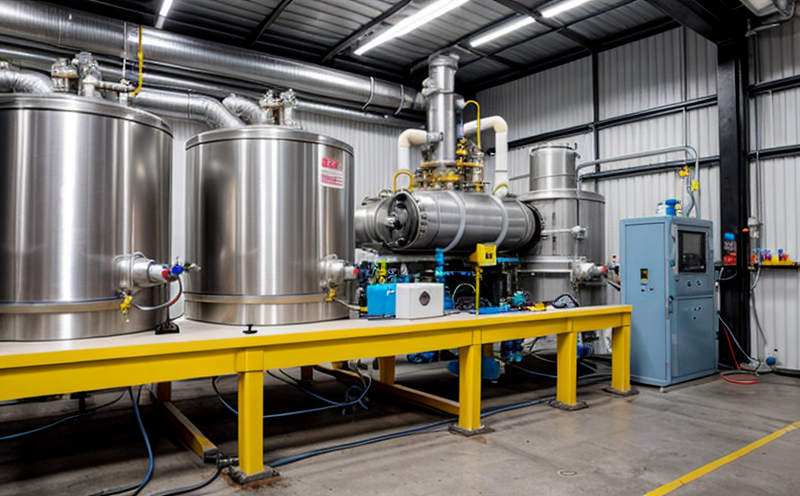ASTM E900 Prediction of Neutron Radiation Damage in Reactor Steels
The ASTM E900 standard provides a method to predict neutron radiation damage in reactor steels by calculating the damage equivalent dose. This service is essential for quality managers, compliance officers, R&D engineers, and procurement teams working with materials exposed to significant neutron fluxes. Neutron activation analysis (NAA) and flux testing play crucial roles in assessing the durability of structural materials used in nuclear reactors. Understanding the potential long-term effects on material properties due to radiation exposure helps ensure reactor safety and reliability.
The ASTM E900 method involves a series of calculations based on neutron fluence, energy spectrum, and material properties. By predicting the damage before actual irradiation testing, this service allows for informed decisions regarding material selection and design optimization. This predictive capability is vital in optimizing the performance and lifespan of reactor components without undergoing full-scale irradiation.
The process begins with a detailed analysis of the expected neutron environment within the reactor. This includes understanding the energy spectrum and fluence rate, which are critical inputs for the ASTM E900 calculations. Once these parameters are established, the service calculates the damage equivalent dose that can be used to predict material degradation. It is important to note that this method provides a probabilistic approach rather than a deterministic one.
The accuracy of the predictions made by ASTM E900 depends heavily on the quality and completeness of the input data. Therefore, precise measurement and characterization of the neutron environment are essential. This can involve using advanced detectors and simulations to model the radiation field accurately. The service also leverages expertise in materials science and nuclear engineering to ensure robustness in predictions.
In addition to predicting damage, the ASTM E900 method provides insights into how different alloying elements affect material performance under neutron irradiation conditions. This knowledge is invaluable for R&D teams looking to develop new alloys or modify existing ones with improved radiation resistance. By using this service early in the design phase, engineers can make informed choices about material composition and microstructure to enhance reactor safety.
This predictive approach not only reduces the need for extensive irradiation testing but also accelerates product development cycles by providing valuable information upfront. It allows organizations to focus resources on areas where they are most needed, reducing costs associated with unnecessary experiments or failures during later stages of development.
The service includes detailed reports summarizing the calculations performed and their implications for material performance in a nuclear environment. These reports serve as crucial documentation supporting regulatory compliance requirements and internal quality assurance processes.
- Benefits:
- Avoids unnecessary irradiation testing, saving time and resources.
- Provides early insights into material behavior under neutron radiation conditions.
- Simplifies the design optimization process by predicting potential issues before they arise.
- Customer Impact and Satisfaction:
- Enhanced confidence in reactor component performance through precise predictions based on actual expected conditions.
- Reduced risk of costly failures due to unexpected radiation damage.
- Streamlined regulatory approval processes by providing robust data for compliance demonstrations.
Eurolab Advantages
At Eurolab, our team of experts ensures that every prediction made using ASTM E900 is accurate, reliable, and tailored to the specific requirements of your project. Our advanced facilities and state-of-the-art instrumentation provide precise measurements necessary for successful predictions.
We maintain strict adherence to international standards such as ASTM E900 and EN 15276. This commitment ensures that our services meet high-quality benchmarks recognized globally, enhancing trust among clients and stakeholders.
Our comprehensive suite of services extends beyond just the prediction phase; it includes support throughout the entire product lifecycle, from initial design through final deployment. Our experienced professionals are dedicated to ensuring you receive the best possible outcomes for your projects involving neutron radiation damage analysis in reactor steels.
Customer Impact and Satisfaction
Clients who utilize our ASTM E900 prediction services report increased confidence in their material choices, reduced risks associated with unexpected failures due to radiation damage, and streamlined regulatory approval processes. These benefits contribute significantly to improved reactor safety and operational efficiency.
- Enhanced Confidence: Precise predictions lead to more informed decision-making regarding material selection.
- Reduced Risk of Failures: Early identification of potential issues prevents costly failures during later stages of development or operation.
- Streamlined Compliance Processes: Robust data provided by our services supports compliance with regulatory requirements, making the approval process smoother and faster.
Client satisfaction is our top priority. By offering accurate predictions based on actual expected conditions and providing detailed reports that serve as essential documentation for both internal quality assurance processes and external regulatory compliance, we ensure that clients receive exceptional value from their investment in these services.





